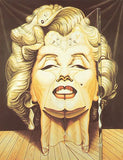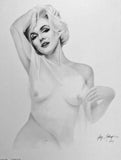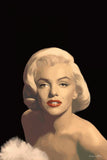Marilyn in the Mirror by Octavio Ocampo
Marilyn in the Mirror is a metamorphic art print by Octavio Ocampo of Marilyn Monroe, born Norma Jean Mortenson on June 1, 1926 in Los Angeles, California. She was an illegitimate child whose father, Edward Mortenson, had deserted her mother, Gladys Baker, before she was born. She endured a childhood of poverty, misery, sexual abuse at the age of eight, and years in foster homes and orphanages after her mother suffered a nervous breakdown and was institutionalized. Escape from this cycle came at the age of sixteen with an arranged marriage to a 21 year old aircraft plant worker.
While working at the Radio Plane Company factory in Burbank, she had her picture taken by a visiting Army photographer. Norma Jean then began modeling bathing suits and, after bleaching her hair blonde, began posing for pinups and glamour photos. Howard Hughes saw some of her photographs and expressed an interest in giving her a screen test for RKO, but Ben Lyon of 20th Century-Fox beat Hughes to the punch, signing Norma Jean Baker to a contract and changing her name to Marilyn Monroe.
Marilyn achieved celebrity with starring roles in three 1953 features—Niagra, Gentlemen Prefer Blondes and How To Marry A Millionaire. She also posed in a series of nude calendar photos, taken in 1948, which appeared in the December 1953 debut issue of Playboy magazine. By the end of the year, Monroe had been voted the top star of 1953 by American film distributors.
In all her film roles, from Niagara to The Misfits, Monroe portrayed an object of desire and exhibition. Her basic character grew out of the dumb blonde stereotype. Frequently her characters were nameless, further accentuating her status as an object. But to the dumb blonde stereotype, Monroe added a sense of innocence, naturalism and overt sexuality. Time magazine's sanguine response to Monroe's Playboy centerfold summed up her appeal: "Marilyn believes in doing what comes naturally." Along with this kindly, innocent sexuality went vulnerability. Monroe's characters were often humiliated at the expense of a voyeuristic pleasure, whether being lassoed like a cow in Bus Stop or exposing herself unknowingly in Some Like It Hot.
Marilyn's personal problems included failed marriages to baseball star Joe DiMaggio and playwright Arthur Miller. Increasing reliance on drugs to combat depression, along with her personal demons, and precarious involvement with people in high places, eventually overwhelmed her. On August 5, 1962, she was found dead of an overdose of sleeping pills. Monroe's story was a tragedy in which the public, the media, and the Hollywood power brokers all share blame. As Laurence Olivier once remarked, "Popular opinion and all that goes to promote it is a horribly unsteady conveyance for life, and she was exploited beyond anyone's means."






